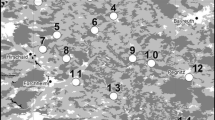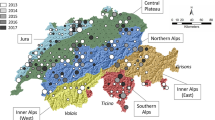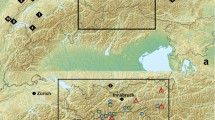Abstract
Many studies aim at testing the impact of recent fragmentation on the genetic diversity and connectivity of populations, while some species do exist naturally in fragmented landscapes because of their habitat requirements. Therefore, it is important to look at the genetic signatures of species occurring in naturally fragmented landscapes in order to disentangle the effect of fragmentation from the effect of habitat requirements. We selected two Nymphalid butterflies for this purpose. While Melanargia galathea is a common butterfly in flower-rich meadows, Melitaea aurelia is closely connected to calcareous grasslands, thus being historically fragmented due to its ecological demands. For the analysis of the genetic response on these opposed patterns, we analysed 18 allozyme loci for 789 individuals (399 individuals of M. galathea and 390 individuals of M. aurelia) in a western German study region with adjacent areas in Luxemburg and northeastern France. Both species showed similarly low genetic differentiations among local populations (M. galathea: F ST 3.3%; M. aurelia: F ST 3.6%), both combined with a moderate level of inbreeding. Isolation-by-distance analysis revealed a significant correlation for both species with similar amounts of explained variances (M. galathea: r 2 = 27.8%; M. aurelia: r 2 = 28.5%). Most parameters of genetic diversity were higher in M. galathea than in M. aurelia, but the latter species had a considerably higher amount of rare or locally restricted genes; the differing ecological demands are thus reflected in these differences. Both species thus seem to be genetically well suited to their respective ecological requirements. In the light of conservation genetics, we deduce that highly fragmented populations are not necessarily prone to extinction. The extinction risk might be linked to the life history of an organism and its population genetic structure.


Similar content being viewed by others
References
Baguette M, Petit S, Quéva F (2000) Population spatial structure and migration of three butterfly species within the same habitat network: consequences for conservation. J Appl Ecol 37:100–108. doi:10.1046/j.1365-2664.2000.00478.x
Bereczki J, Pecsenye K, Peregovits L, Varga Z (2005) Pattern of genetic differentiation in the Maculinea alcon species group (Lepidoptera, Lycaenidae) in Central Europe. J Zool Syst Evol Res 43:157–165. doi:10.1111/j.1439-0469.2005.00305.x
Bermingham E, Avise JC (1986) Molecular zoogeography of freshwater fishes in the southeastern United States. Genetics 113:939–965
Bink FA (1992) Ecologische Atlas van de Dagvlinders van Noordwest-Europa. Schuyt & Co Uitgevers en Importeurs, Netherlands
Brookes MI, Graneau YA, King P, Rose OC, Thomas CD, Mallet JLB (1997) Genetic analysis of founder bottlenecks in the rare british butterfly Plebejus argus. Conserv Biol 11:648–661. doi:10.1046/j.1523-1739.1997.96163.x
Cunningham M, Moritz C (1998) Genetic effects of forest fragmentation on a rainforest restricted lizard (Scincidae: Gnypetoscincus queenslandiae). Biol Conserv 83:19–30. doi:10.1016/S0006-3207(97)00046-3
Den Boer P-J (1981) On the survival of populations in a heterogenous and variable environment. Oecologia 50:39–53. doi:10.1007/BF00378792
Ebert G, Rennwald E (eds) (1991a) Die Schmetterlinge Baden-Württembergs 1. Eugen Ulmer Verlag, Germany
Ebert G, Rennwald E (eds) (1991b) Die Schmetterlinge Baden-Württembergs 2. Verlag Eugen Ulmer, Germany
Frankham R (1995) Conservation genetics. Annu Rev Genet 29:305–327. doi:10.1146/annurev.ge.29.120195.001513
Frankham R, Ballou JD, Briscoe DA (2002) Introduction to conservation genetics. Cambridge University Press, United Kingdom
Gadeberg RME, Boomsma J (1997) Genetic population structure of the large blue butterfly Maculinea alcon in Denmark. J Insect Conserv 1:99–111. doi:10.1023/A:1018439211244
Geiger H, Shapiro AM (1992) Genetics, systematics and evolution of holarctic Pieris napi species group populations (Lepidoptera, Pieridae). Zeitschrift für Zoologie. Systematik Evolutionsforschung 30:100–122
Hanski I (1991) Single species metapopulation dynamics: concepts, models, and observations. Biol J Linn Soc Lond 42:17–38. doi:10.1111/j.1095-8312.1991.tb00549.x
Hanski I (1999) Metapopulation ecology. Oxford University Press, UK
Hanski I, Simberloff D (1997) Metapopulation biology: ecology, genetics, and evolution. Academic Press, United Kingdom
Hansson B, Westerberg L (2002) On the correlation between heterozygosity and fitness in natural populations. Mol Ecol 11:2467–2474. doi:10.1046/j.1365-294X.2002.01644.x
Harris H, Hopkinson DA (1978) Handbook of enzyme electrophoresis in human genetics. University Amsterdam, Netherlands
Harrison S, Hastings A (1996) Genetic and evolutionary consequences of metapopulation structure. Trends Evol Ecol 11:180–183. doi:10.1016/0169-5347(96)20008-4
Hebert PDN, Beaton MJ (1993) Methodologies for allozyme analysis using cellulose acetat electrophoresis. Helena Laboratories, USA
Hill JK, Thomas CD, Lewis OT (1996) Effects of habitat patch size and isolation on dispersal by Hesperia comma butterflies: implications for metapopulation structure. J Anim Ecol 65:725–735. doi:10.2307/5671
Holzhauer SIJ, Ekschmitt K, Sanders A-C, Dauber J, Wolters V (2005) Effect of historic landscape change on the genetic structure of the bush-cricket Metrioptera roeseli. Landsc Ecol 34:23–35
http://www.xlstat.com/de/home/, July 2006
Joyce DA, Pullin AS (2001) Phylogeography of the marsh fritillary Euphydryas aurinia (Lepidoptera: Nymphalidae) in the UK. Biol J Linn Soc Lond 72:129–141. doi:10.1111/j.1095-8312.2001.tb01305.x
Kelley ST, Farrell BD, Mitton JB (2000) Effects of specialization on genetic differentiation in sister species of bark beetles. Heredity 84:218–227. doi:10.1046/j.1365-2540.2000.00662.x
Knutsen H, Rukke BA, Jorde PE, Ims RA (2000) Genetic differentiation among populations of the beetle Bolitophagus reticulatus (Coleoptera: Tenebrionidae) in a fragmented and a continuous landscape. Heredity 84:667–676. doi:10.1046/j.1365-2540.2000.00691.x
Kraus W (1993) Verzeichnis der Großschmetterlinge Insecta Lepidoptera der Pfalz. Pollichia, Germany
Lacy RC (1987) Loss of genetic diversity from managed populations: interacting effects of drift, mutation, immigration, selection and population subdivision. Conserv Biol 1:143–158. doi:10.1111/j.1523-1739.1987.tb00023.x
Levins R (1970) Extinction, some mathematical questions in biology, lectures on mathematics in life science 2. In: Gerstenhaber M (ed) American Mathematical Society, Rhode Island, pp 77–107
Lewis OT, Thomas CD, Hill JK, Brookes MI, Crane TPR, Graneau YA, Mallet JLB, Rose OC (1997) Three ways of assessing metapopulation structure in the butterfly Plebejus argus. Ecol Entomol 22:283–293. doi:10.1046/j.1365-2311.1997.00074.x
Louis EJ, Dempster ER (1987) An exact test for Hardy-Weinberg and multiple alleles. Biometrics 43:805–811. doi:10.2307/2531534
Louy D, Habel JC, Schmitt T, Assmann T, Meyer M, Müller P (2007) Strongly diverging population genetic patterns of three skipper species: isolation, restricted gene flow and panmixis. Conserv Genet 8:671–681. doi:10.1007/s10592-006-9213-y
MacArthur R-H, Wilson E-O (1967) The theory of island biogeography. Princeton University Press, Princeton
Madsen T, Shine R, Olsson M, Wittzell H (1999) Restoration of an inbred adder population. Nature 402:34–35. doi:10.1038/46941
McCarthy MA, Lindenmayer DB (1999) Incorporating metapopulation dynamics of greater gliders into reserve design in disturbed landscape. Ecology 80:651–667
Nei M (1978) Estimation of average heterozygosity and genetic distance from a small number of individuals. Genetics 89:583–590
Nève G, Barascud B, Descimon H, Baguette M (2000) Genetic structure of Proclossiana eunomia populations at the regional scale (Lepidoptera, Nymphalidae). Heredity 84:657–666. doi:10.1046/j.1365-2540.2000.00699.x
Oostermeijer JGB, Brugman ML, De Boer ER, Den Nijs HCM (1996) Temporal and spatial variation in the demography of Gentiana pneumonanthe, a rare perennial herb. J Ecol 84:166–174. doi:10.2307/2261351
Peacock MM, Smith AT (1997) The effect of habitat fragmentation on dispersal patterns, mating behavior and genetic variation in a pika (Ochotona princeps) metapopulation. Oecologia 112:524–533. doi:10.1007/s004420050341
Reed DH, Frankham R (2003) Correlation between fitness and genetic diversity. Conserv Biol 17:230–237. doi:10.1046/j.1523-1739.2003.01236.x
Richardson BJ, Baverstock PR, Adams M (1986) Allozyme electrophoresis, a handbook for animal systematics and population studies. Academic Press, USA
Schmidt-Koehl W (1977) Die Groß-Schmetterlinge des Saarlandes (Insecta, Lepidoptera): Tagfalter, Spinner und Schwärmer. Abhandlungen der Arbeitsgemeinschaft für tier- und pflanzengeografische Heimatforschung im Saarland 7:1–231
Schmitt T, Seitz A (2002) Influence of habitat fragmentation on the genetic structure of Polyommatus coridon (Lepidoptera: Lycaenidae): implications for conservation. Biol Conserv 107:291–297. doi:10.1016/S0006-3207(02)00066-6
Schmitt T, Seitz A (2004) Low diversity but high differentiation: the population genetics of Aglaope infausta (Zygaenidae: Lepidoptera). J Biogeogr 31:137–144. doi:10.1111/j.1365-2699.2004.01079.x
Schmitt T, Gießl A, Seitz A (2003) Did Polyommatus icarus (Lepidoptera: Lycaenidae) have distinct glacial refugia in southern Europe?—evidence from population genetics. Biol J Linn Soc Lond 80:529–538. doi:10.1046/j.1095-8312.2003.00261.x
Schmitt T, Röber S, Seitz A (2005) Is the last glaciation the only relevant event for the present genetic population structure of the Meadow Brown butterfly Maniola jurtina (Lepidoptera: Nymphalidae)? Biol J Linn Soc Lond 85:419–431. doi:10.1111/j.1095-8312.2005.00504.x
Schneider S, Roessli D, Excoffier L (2000) Arlequin ver. 2.000—a software for population genetics data analysis. University of Genève, Switzerland
Siegismund HR (1993) G-Stat, ver. 3, genetical statistical programs for the analysis of population data. Denmark, Royal Veterinary and Agricultural University, The Arboretum
Taylor PD, Fahrig L, Henein K, Merriam G (1993) Connectivity is a vital element of landscape structure. Oikos 68:571–573. doi:10.2307/3544927
Thomas JA, Elmes GW (2001) Food-plant niche selection rather than the presence of ant nest explains ovipostion patterns in the myrmecophilous butterfly genus Maculinea. Proc R Soc Lond B Biol Sci 268:471–477. doi:10.1098/rspb.2000.1398
Thomas JA, Bourn NAD, Clarke RT, Stewart KE, Simcox DJ, Pearman GS, Curtis R, Goodger B (2001) The quality and isolation of habitat patches both determine where butterflies persist in fragmented landscapes. Proc R Soc Lond B Biol Sci 268:1791–1796. doi:10.1098/rspb.2001.1693
Vandewoestijne S, Nève G, Baguette M (1999) Spatial and temporal population genetic structure of the butterfly Aglais urticae L. (Lepidoptera, Nymphalidae). Mol Ecol 8:1539–1543. doi:10.1046/j.1365-294x.1999.00725.x
Vandewoestijne S, Martin T, Liégeois S, Baguette M (2004) Dispersal, landscape occupancy and popualtion structure in the butterfly Melanargia galathea. Basic Appl Ecol 5:581–591. doi:10.1016/j.baae.2004.07.004
Weir BS (1991) Genetic data analysis. Sinauer, Netherlands
Wenzel M, Schmitt T, Weitzel M, Seitz A (2006) The severe decline of butterflies on western German calcareous grasslands during the last 30 years: a conservation problem. Biol Conserv 128:542–552. doi:10.1016/j.biocon.2005.10.022
Wilcox BA, Murphy DD (1985) Conservation strategy: the effects of fragmentation on extinction. Am Nat 125:879–887. doi:10.1086/284386
Wilson RJ, Ellis S, Baker JS, Lineham ME, Whitehead RW, Thomas CD (2002) Large-scale patterns of distribution and persistence at the range margins of a butterfly. Ecology 83:3357–3368
Wood BC, Pullin AS (2002) Persistence of species in a fragmented urban landscape: the importance of dispersal ability and habitat availability for grassland butterflies. Biodivers Conserv 11:11451–11468. doi:10.1023/A:1016223907962
Wynhoff I (2001) At home on foreign meadows, the reintroduction of two Maculinea butterfly species. Agricultural University, Netherlands, Wageningen
Young A, Boyle T, Brown T (1996) The population genetic consequences of habitat fragmentation for plants. Trends Evol Ecol 11:413–419. doi:10.1016/0169-5347(96)10045-8
Acknowledgement
We acknowledge a grant from the German Science Foundation DFG (grant number SCHM 1659/3-1 and 3-2) and the scholarship “Arten- und Biotopschutz” of the Ministry of Rhineland-Palatinate, enabling the collecting trips and the allozyme electrophoresis. We are grateful to the governments of the Rhineland-Palatinate, the Saarland and Luxembourg for the sampling permits and to France not demanding such a permission. We thank Desmond Kime for critical comments on a draft version of this article and for the correction of our English.
Author information
Authors and Affiliations
Corresponding author
Appendix
Appendix
See Table 6.
Rights and permissions
About this article
Cite this article
Habel, J.C., Meyer, M. & Schmitt, T. The genetic consequence of differing ecological demands of a generalist and a specialist butterfly species. Biodivers Conserv 18, 1895–1908 (2009). https://doi.org/10.1007/s10531-008-9563-5
Received:
Accepted:
Published:
Issue Date:
DOI: https://doi.org/10.1007/s10531-008-9563-5




